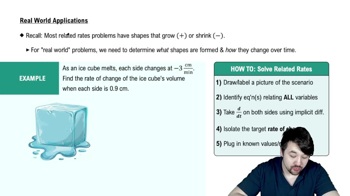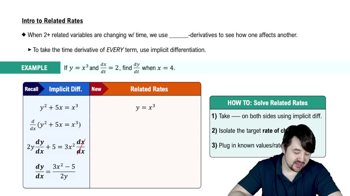Table of contents
- 0. Functions7h 52m
- Introduction to Functions16m
- Piecewise Functions10m
- Properties of Functions9m
- Common Functions1h 8m
- Transformations5m
- Combining Functions27m
- Exponent rules32m
- Exponential Functions28m
- Logarithmic Functions24m
- Properties of Logarithms34m
- Exponential & Logarithmic Equations35m
- Introduction to Trigonometric Functions38m
- Graphs of Trigonometric Functions44m
- Trigonometric Identities47m
- Inverse Trigonometric Functions48m
- 1. Limits and Continuity2h 2m
- 2. Intro to Derivatives1h 33m
- 3. Techniques of Differentiation3h 18m
- 4. Applications of Derivatives2h 38m
- 5. Graphical Applications of Derivatives6h 2m
- 6. Derivatives of Inverse, Exponential, & Logarithmic Functions2h 37m
- 7. Antiderivatives & Indefinite Integrals1h 26m
4. Applications of Derivatives
Related Rates
Problem 58
Textbook Question
{Use of Tech} Flow from a tank A cylindrical tank is full at time t=0 when a valve in the bottom of the tank is opened. By Torricelli’s law, the volume of water in the tank after t hours is V=100(200−t)², measured in cubic meters.
c. Find the rate at which water flows from the tank and plot the flow rate function.
 Verified step by step guidance
Verified step by step guidance1
Step 1: Understand the problem. We need to find the rate at which water flows from the tank. This is the derivative of the volume function V with respect to time t, which gives us the flow rate function.
Step 2: Identify the volume function. The volume of water in the tank at time t is given by V(t) = 100(200 - t)^2.
Step 3: Differentiate the volume function with respect to time t. Use the chain rule to find the derivative of V(t). The chain rule states that if you have a composite function, the derivative is the derivative of the outer function evaluated at the inner function times the derivative of the inner function.
Step 4: Apply the chain rule. Let u = 200 - t, then V(t) = 100u^2. The derivative of V with respect to u is 200u, and the derivative of u with respect to t is -1. Therefore, the derivative of V with respect to t is dV/dt = 200u * (-1).
Step 5: Substitute back the expression for u. Since u = 200 - t, substitute this back into the derivative to get the flow rate function: dV/dt = -200(200 - t). This function represents the rate at which water flows from the tank.
Recommended similar problem, with video answer:
 Verified Solution
Verified SolutionThis video solution was recommended by our tutors as helpful for the problem above
Video duration:
6mPlay a video:
Was this helpful?
Related Videos
Related Practice






